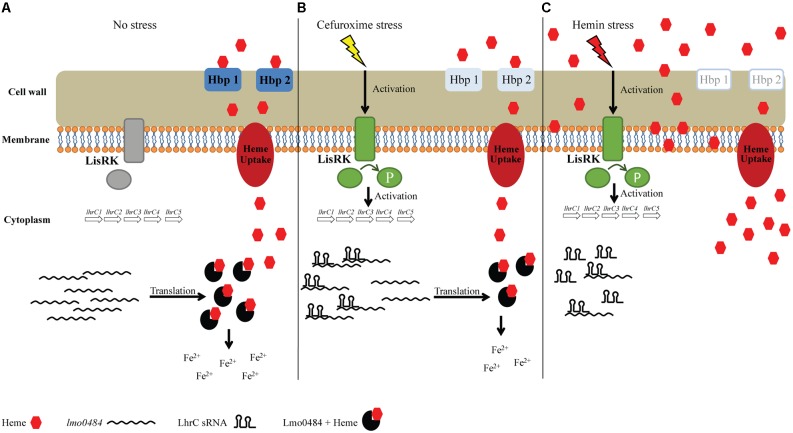FIGURE 9.
Proposed model of the regulatory effect of LhrC1–5 on heme uptake and utilization genes. (A) During growth in BHI medium, there is no activation of the TCS LisRK and subsequently LhrC1–5 are not induced. Under this condition, lmo0484, lmo2186, and lmo2185 are expressed and heme-uptake from the BHI medium is taking place according to the cells’ needs. The lmo0484 mRNA is translated into a IsdG-like heme oxygenase, which will catalyze the degradation of heme to obtain free iron. (B) When the cells are subjected to cefuroxime stress, LisRK will be activated. LhrC1–5 are then induced and can bind lmo0484 mRNAs. Binding of LhrC sRNA to the SD region of lmo0484 mRNA leads to inhibition of translation. Under cefuroxime stress, LhrC1–5 most likely act to control the expression of the heme uptake genes lmo2186 and lmo2185 in a similar fashion (not shown). Thus, when exposed to cefuroxime, LhrC1–5 act to fine-tune the expression of heme uptake and utilization genes, suggesting a need for L. monocytogenes to slightly reduce the uptake of heme when the cell envelope is being stressed. (C) Under hemin stress, LhrC1–5 are strongly induced as well in a LisR-dependent manner. Furthermore, when the cell faces high concentrations of heme, the mRNA levels of lmo0484 are almost immediately diminished by an unknown mechanism. In this situation, LhrC1–5 will bind the remaining lmo0484 mRNAs in the cell and act as ‘vacuum cleaners’ to avoid translation of the residual lmo0484 mRNA. The heme uptake genes lmo2185 and lmo2186 are most likely controlled by heme and LhrC1–5 in a similar fashion (not shown). Consequently, the expression of heme acquisition genes is quickly reduced in response to heme stress to avoid further uptake of heme and liberation of iron.

